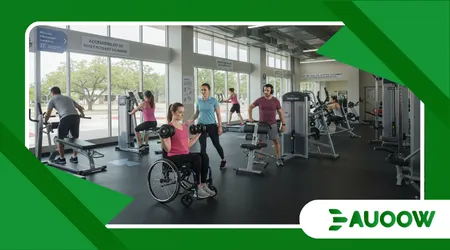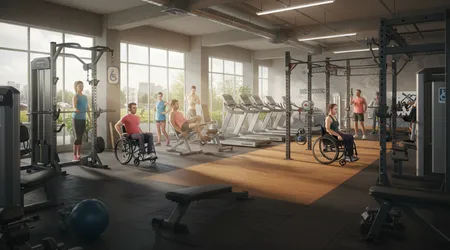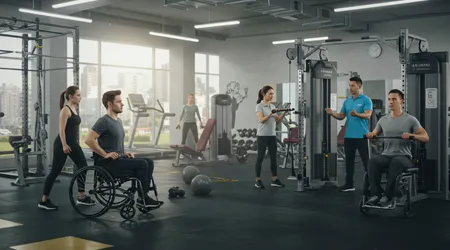Accessibility at the Gym: What to Expect and Demand

Accessibility at the gym is no longer a niche concern it’s a fundamental expectation for inclusive fitness spaces in 2025.
Gyms are evolving, driven by growing awareness of diverse needs, legal mandates like the Americans with Disabilities Act (ADA), and a cultural shift toward equity.
But what does true accessibility mean for gym-goers with disabilities? It’s about dismantling barriers physical, sensory, and attitudinal to ensure everyone can exercise with dignity.
This article explores what you should expect from an accessible gym, what to demand when standards fall short, and why prioritizing accessibility at the gym matters for all.
Imagine a gym as a public square: if it excludes anyone, it fails its purpose. Let’s dive into creating spaces where everyone thrives.
Understanding Gym Accessibility in 2025
Accessible gyms prioritize universal design, ensuring usability for all. Ramps, wide doorways, and tactile signage are baseline expectations for accessibility at the gym.
The ADA sets standards, but many facilities lag, with only 44% of U.S. gyms fully compliant, per a 2023 National Disability Institute study.
Beyond physical access, sensory and cognitive accommodations like clear instructions or quiet zones matter.
Picture a wheelchair user navigating a cluttered weight room: it’s not just inconvenient; it’s exclusionary.
Gyms must also train staff to assist without patronizing. An accessible gym fosters independence, not dependence.
For instance, a visually impaired member might need equipment with braille labels, not constant hand-holding.
++ Managing Medication with Low Vision: Helpful Tools
Technology, like apps with screen-reader compatibility, enhances accessibility at the gym by offering workout guidance.
Expect gyms to integrate these tools, reflecting 2025’s tech-driven fitness trends.
Yet, accessibility isn’t just about equipment or layout. It’s about culture. A gym that welcomes diverse needs signals inclusivity through signage, policies, and staff demeanor.
Demand gyms that actively consult disability communities to shape their offerings, ensuring accessibility at the gym is proactive, not reactive.

Physical Accessibility: Beyond Ramps and Doorways
Ramps are a start, but accessibility at the gym demands more. Wide pathways (at least 36 inches) allow wheelchair navigation.
Equipment like adjustable benches or cable machines with low handles supports diverse mobility needs.
For example, a gym in Seattle recently installed hydraulic benches, enabling users with limited strength to adjust settings independently.
Accessible locker rooms are non-negotiable. Roll-in showers, grab bars, and benches with backrests ensure safety.
Also read: How to Advocate for Better Accessibility in Your Neighborhood
A 2024 fitness industry report noted 60% of gym complaints from disabled users cite locker room inaccessibility.
Demand facilities with family-style changing rooms for privacy and space, reflecting accessibility at the gym as a holistic priority.
Parking and entry points matter, too. Accessible parking must be close, with clear paths to entrances. Automatic doors or lever handles ease access.
If a gym’s entrance has steps without a ramp, it’s a red flag. Advocate for retrofits modern gyms must prioritize accessibility at the gym to serve all members effectively.
Sensory and Cognitive Inclusion
Not all disabilities are visible. Accessibility at the gym includes sensory-friendly spaces for neurodivergent individuals or those with auditory sensitivities.
Dimmed lighting or quiet hours reduce sensory overload. A gym in London offers “low-sensory evenings,” proving this is achievable.
Clear signage with large, high-contrast text aids those with visual impairments. Cognitive accessibility means simple, jargon-free instructions.
Read more: The Best Phones for Accessibility Features in 2025
For instance, a gym might use pictograms on machines to guide users with intellectual disabilities. Demand gyms provide staff trained in autism awareness or sensory processing to enhance accessibility at the gym.
Technology plays a role here, too. Apps with voice narration or haptic feedback help visually impaired users navigate workouts. Why should anyone be excluded from fitness due to sensory barriers?
Gyms must innovate, ensuring accessibility at the gym embraces diverse sensory and cognitive needs.
Staff Training and Cultural Competence
A gym’s culture shapes its accessibility. Staff trained in disability etiquette can make or break the experience.
For example, a gym member with cerebral palsy was once offered unsolicited “help” that felt condescending proper training prevents this. Expect staff to know how to assist without assuming limitations.
Cultural competence extends to communication. Staff should be versed in basic sign language or use communication boards for non-verbal members.
A 2024 survey by the Inclusive Fitness Coalition found 78% of disabled gym-goers value staff who listen over those who “fix.”
Demand ongoing training to ensure accessibility at the gym is empathetic and informed.
Gyms should also hire diverse staff, including those with disabilities, to model inclusivity. A trainer with a prosthetic limb, for instance, inspires and understands unique needs.
Advocate for gyms to foster a culture where accessibility at the gym is a lived value, not a checklist.
Technology and Equipment for All
Modern gyms lean on technology, and accessibility at the gym must keep pace. Equipment with adjustable resistance, like pneumatic machines, suits varied strength levels.
For example, a gym in Chicago introduced voice-activated treadmills, allowing blind users to control settings independently.
Wearable tech, like smartwatches with haptic feedback, helps deaf users track workouts. Apps with screen-reader compatibility or closed-captioned workout videos are essential.
A 2025 fitness tech report highlighted 30% of new gym apps now include accessibility features, a leap from 2023.
Retrofitting older equipment is costly but necessary. Demand gyms invest in universal design think handcycles or seated ellipticals.
If a gym’s tech excludes users, it’s not just outdated; it’s discriminatory. Push for accessibility at the gym through equipment that empowers everyone.
Advocacy: Demanding Better Standards
Gyms often claim accessibility but fall short. Advocacy starts with knowing your rights. The ADA mandates equal access, yet enforcement varies.
If a gym lacks ramps or braille signage, report it to local authorities or disability advocacy groups.
Engage gym management directly. Share specific needs like adjustable equipment or sensory-friendly hours.
For instance, a group of autistic members in Austin successfully lobbied for a “quiet zone” by presenting a petition. Collective action amplifies impact, ensuring accessibility at the gym improves.
Social media is a powerful tool. Post about accessibility gaps, tagging gyms and using hashtags like #InclusiveFitness.
Public pressure drives change. Demand transparency gyms should publish accessibility audits online. Accessibility at the gym thrives when members hold facilities accountable.
Policy and Community Engagement

Gyms must align with broader inclusivity policies. Partnering with disability organizations ensures accessibility at the gym reflects real needs.
For example, a California gym collaborated with a local blindness association to design tactile equipment guides, boosting membership by 15%.
Policies should include feedback mechanisms. Suggestion boxes or online surveys let members voice accessibility concerns.
A 2024 study showed gyms with feedback systems saw 25% higher retention among disabled members. Demand gyms prioritize community input for accessibility at the gym.
Local governments can incentivize accessibility through grants. Advocate for policies rewarding gyms that exceed ADA standards.
Community-driven initiatives, like inclusive fitness classes, foster belonging. Accessibility at the gym grows when policies and engagement align with user needs.
The Broader Impact of Accessible Gyms
Accessible gyms benefit everyone. Wide doorways aid parents with strollers; clear signage helps non-native speakers.
A 2024 Inclusive Fitness Coalition report found accessible gyms increased overall membership by 20%, as inclusivity attracts diverse clients.
Economically, accessibility drives revenue. Disabled individuals represent a $490 billion market in the U.S. alone, per the American Institutes for Research.
Gyms ignoring accessibility at the gym miss out on this demographic, limiting growth.
Socially, inclusive gyms challenge stereotypes. When a wheelchair user lifts alongside others, it normalizes diversity.
Demand gyms champion accessibility at the gym to create spaces where everyone feels valued, fostering a healthier, more equitable society.
| Feature | Description | Impact |
|---|---|---|
| Ramps & Wide Doorways | Minimum 36-inch pathways, ADA-compliant ramps | Enables wheelchair access, improves navigation |
| Adjustable Equipment | Hydraulic benches, low-handle machines | Supports varied mobility and strength levels |
| Sensory-Friendly Zones | Quiet hours, dimmed lighting | Reduces overload for neurodivergent users |
| Trained Staff | Disability etiquette, sign language basics | Enhances user comfort and independence |
| Accessible Technology | Voice-activated machines, screen-reader apps | Empowers blind and deaf users |
Conclusion: A Call to Action
Accessibility at the gym isn’t a luxury it’s a right. In 2025, gyms must move beyond token gestures to create truly inclusive spaces.
Expect ramps, trained staff, and tech that empowers all. Demand accountability through advocacy and community engagement.
Like a bridge connecting isolated islands, accessible gyms unite people, fostering health and belonging. Every step toward accessibility at the gym builds a stronger, more inclusive fitness culture.
Join the movement demand better, and make fitness a right for all.
Frequently Asked Questions
Q: What should I do if my gym isn’t accessible?
A: Document specific issues, like missing ramps, and discuss with management. Escalate to local disability boards or use social media to advocate.
Q: How can I tell if a gym is truly accessible?
A: Check for ADA compliance, trained staff, and sensory accommodations. Ask for an accessibility audit or tour the facility before joining.
Q: Are accessible gyms more expensive to join?
A: Not necessarily. Many gyms integrate accessibility without raising fees, as it attracts more members, offsetting costs.
Q: Can technology alone make a gym accessible?
A: No, technology complements physical and cultural changes. Voice-activated machines help, but ramps and trained staff are equally vital.
